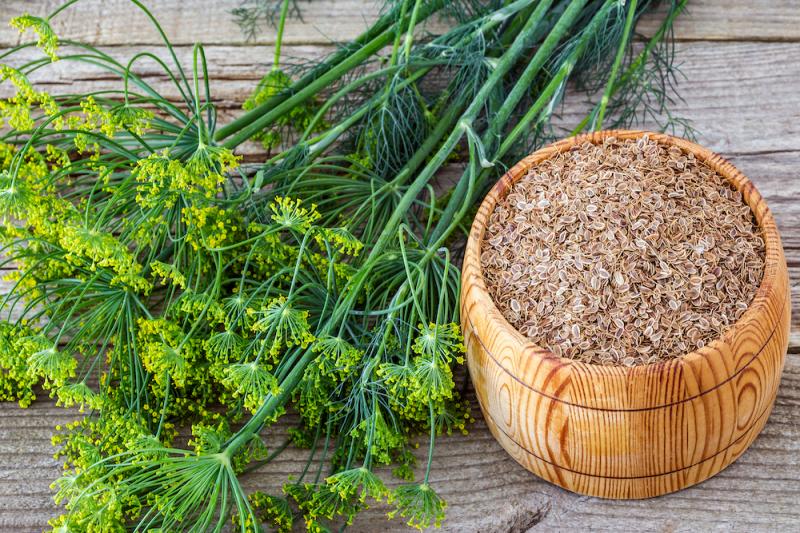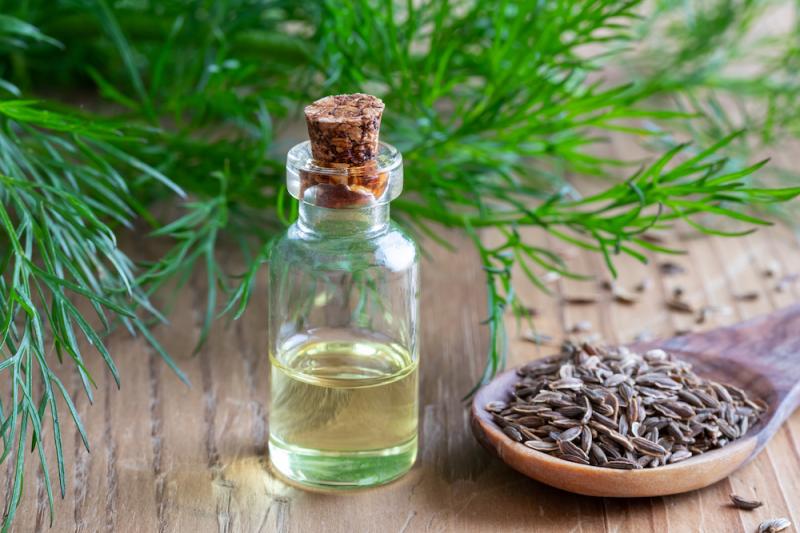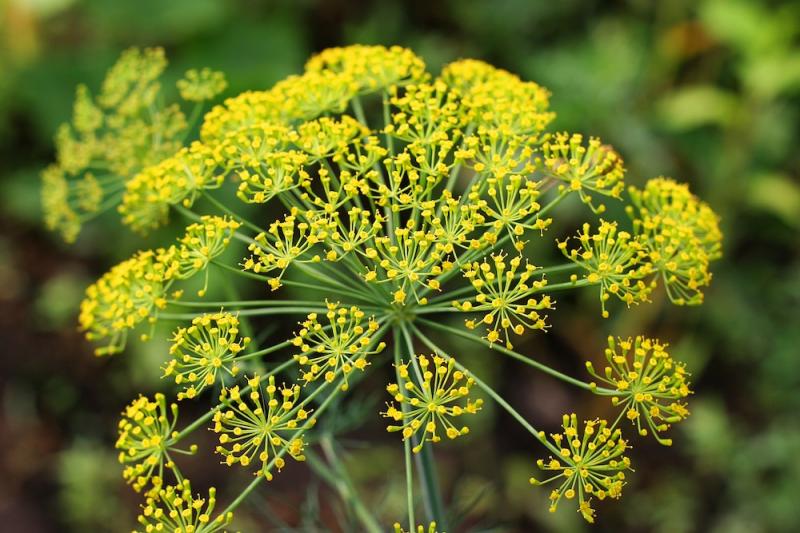
Dill is the major seasoning in borscht, a beet soup, and other soups, salads, and pickled vegetables. Slavic people tend to love dill, and my wife is from Ukraine and loves growing dill and harvesting fresh leaves for soups and salads. In the West, dill is not so widely used except in pickling cucumbers, to make the familiar dill pickles. And I believe people who crave dill pickles may benefit from using dill as an herbal or emotional remedy as described below.
Medicinal Value of Dill
 Like so many kitchen spices, dill has medicinal value. Native to the Mediterranean region, dill is a member of the parsley family, and like many other plants in that family, including anise, fennel, and coriander, it aids digestion. It stimulates digestive secretions and acts as a carminative to reduce bloating and flatulence.
Like so many kitchen spices, dill has medicinal value. Native to the Mediterranean region, dill is a member of the parsley family, and like many other plants in that family, including anise, fennel, and coriander, it aids digestion. It stimulates digestive secretions and acts as a carminative to reduce bloating and flatulence.
It’s also an antispasmodic that relaxes smooth muscles, which means it can relieve stomach and intestinal cramping. So, it eases colic and is a folk remedy for getting rid of hiccups, which are caused by a muscular spasms.
Dill is also used to encourage milk production in nursing mothers. It can also be taken to sweeten the breast milk, preventing or easing colic in the infant.
An essential oil can be steam-distilled from dill seeds. The oil has a fresh, mildly spicy fragrance and also has antispasmodic and carminative properties. It can be diluted and used internally for colic, dyspepsia, indigestion, gas, bloating, and excessive flatulence. It can also be inhaled to relax the bronchial passages in asthma and bronchitis and can be massaged into the abdominal area for dysmenorrhea and muscle cramps.
Emotional Indications for Dill
 I’ve also used dill as a flower essence. I see dill flower essence as one of the two best remedies for the solar plexus, the other being dandelion. The solar plexus is a nerve center right behind the sternum that controls many automatic processes in the body, but especially digestion. It’s also the center of gravity in the body and energetically connected with the adrenal glands, which are the glands of adaptation, these help us cope with difficult experiences. This energy center helps us stay balanced or centered.
I’ve also used dill as a flower essence. I see dill flower essence as one of the two best remedies for the solar plexus, the other being dandelion. The solar plexus is a nerve center right behind the sternum that controls many automatic processes in the body, but especially digestion. It’s also the center of gravity in the body and energetically connected with the adrenal glands, which are the glands of adaptation, these help us cope with difficult experiences. This energy center helps us stay balanced or centered.
When the solar plexus energy is out of balance we lose contact with our gut instincts. This can cause us to become scattered in our mental focus, easily distracted, and overly changeable in our emotions. One way we express this is by saying we’re off-centered.
In contrast, a person who is centered feels in control of their life. They take action on the challenges life brings them. A person who is not in contact with their own center reacts to life. They feel like they are being pulled in many directions and may express the idea that they spend their time putting out fires.
Solar Plexus Energy
 The umbel of flowers in dill (and other members of the parsley family) connects at a specific point from which it branches out in many directions. Dill is a remedy to help someone find that point at which everything in their life connects. The person who needs this remedy is overly sensitive to their environment and is overstimulated by it. They feel overwhelmed by the many demands placed on their time and energy and have difficulty creating priorities and organization in how they approach things. They need to take charge of life instead of allowing life to take charge of them.
The umbel of flowers in dill (and other members of the parsley family) connects at a specific point from which it branches out in many directions. Dill is a remedy to help someone find that point at which everything in their life connects. The person who needs this remedy is overly sensitive to their environment and is overstimulated by it. They feel overwhelmed by the many demands placed on their time and energy and have difficulty creating priorities and organization in how they approach things. They need to take charge of life instead of allowing life to take charge of them.
When our energy is scattered we tend to develop tension in the solar plexus, which is associated with the development of a hiatal hernia. The stomach moves up into the opening in the diaphragm where the esophagus comes through. The person becomes unable to swallow and digest life, which leads us back to dill as a digestive remedy.
Both dill and dandelion have been used in digestive formulas and they also work well together as remedies for a hiatal hernia and a person who has lost touch with their gut instincts. Dandelion helps the person who overstrikes and overplans their life, while dill helps the person whose energy is distracted and scattered. Together they help a person relax and find their center.
Harvesting and Using Dill
Dill is an easy-to-grow annual plant. After sowing the seeds, harvest the leaves while they are green and add them to dishes. Harvest the seeds and seed heads when the plant is dry. You can tincture the seeds and take 20-40 drops three times a day, or crush them and make a tea. For emotional healing take 10 drops of the flower essence (alone or in combination with dandelion flower essence) a couple of times a day.
Steven's Articles
-

-
The Evidence for Berberine
A yellow alkaloid found in traditional infection-fighting…
-

-
The Sensible Use of Caffeinated Herbs
Kola nuts, guarana, and yerba mate and other herbs…
-

-
The Health Benefits and Problems with Coffee
This popular caffeinated beverage can be beneficial…
October
-

-
Understanding Caffeine & Cellular Adaptation
Preserving the power of caffeine's buzz and the…
September
-

-
Horseradish
A pungent spice for aiding protein metabolism…
-

-
Banaba or Crepe Myrtle
A beautiful tree from Southeast Asia whose leaves…
August
-

-
Monkeyflowers
Flower essences to help see ourselves more clearly…
-

-
Mariposa Lilies
Strengthening the bond between mother and child…
-

-
The Noble Bay Leaf
A common kitchen herb for aiding digestion and…
-

-
Epimedium: Horny Goat Weed
A circulatory stimulant and kidney yang tonic…
July
-

-
The Medicinal and Nutritional Benefits of Apricots
A nutritious fruit and valuable medicinal seed for coughs
-

-
Dogwoods
Asian dogwood is used to stop excessive discharge,…
June
-

-
Neem: The Village Pharmacy
A popular Ayurvedic remedy for dental and immune…
-

-
Spilanthes: The Toothache Plant
A traditional remedy for teeth and gums, as well…
-

-
Forsythia
An anti-inflammatory, fever-reducing, and infection fighting herb

